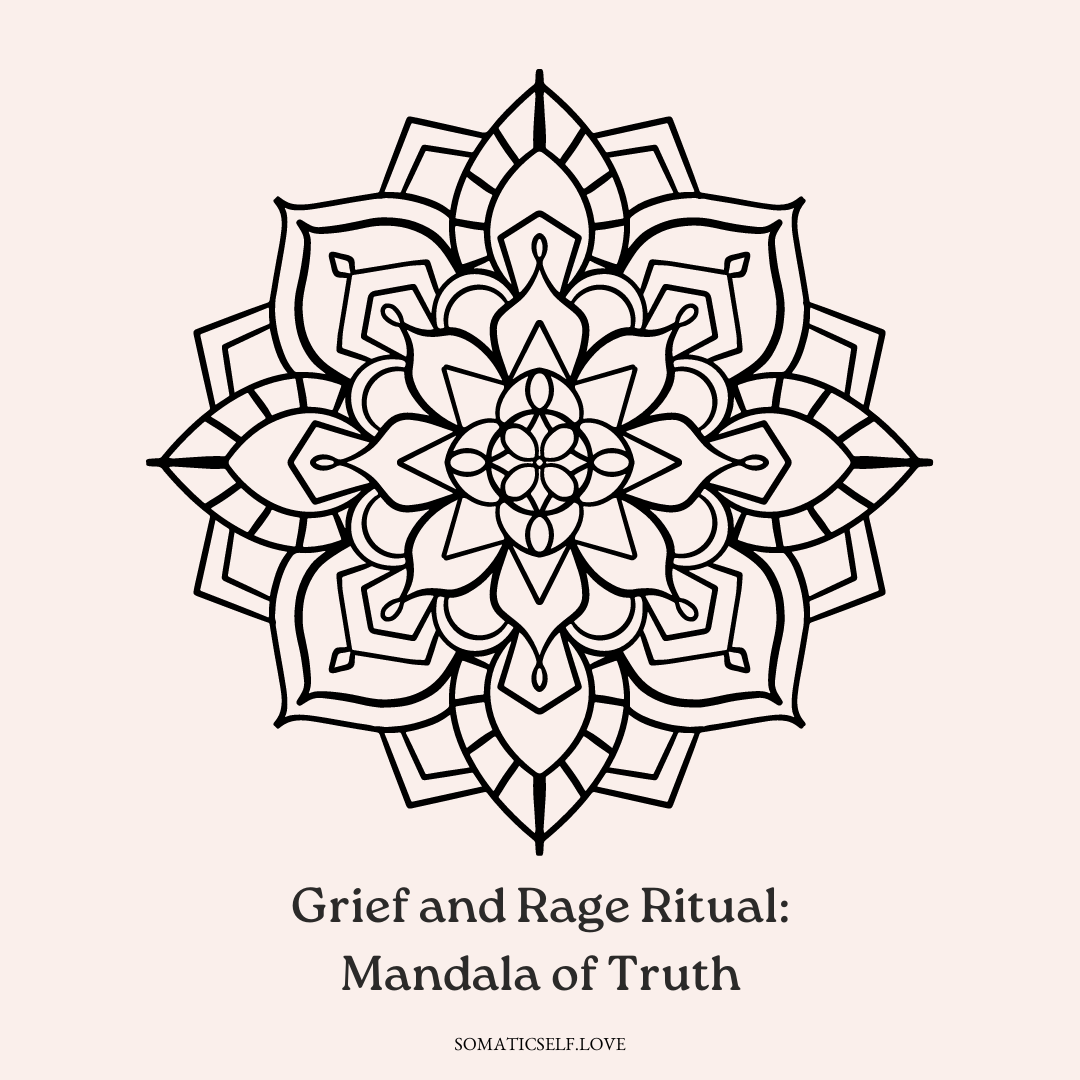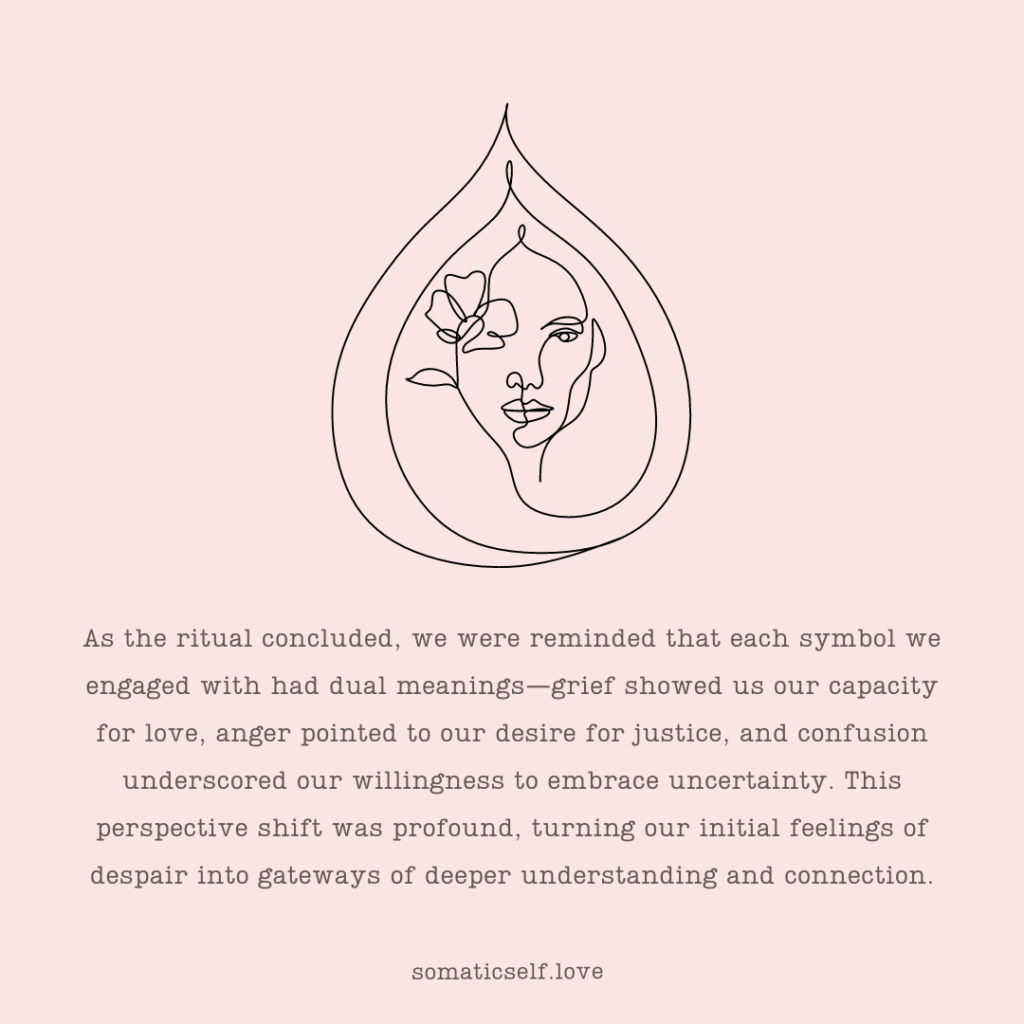Transformative Grief and Rage Ritual: A Personal Journey

Navigating through the landscape of grief and trauma can be an intensely private journey, yet there exists profound power in communal healing. Over the years, I’ve had the opportunity to participate and then lead grief and rage rituals, a ceremonies designed not only to acknowledge these heavy emotions but also to transform them through the collective energy of support and understanding.
This ritual, deeply rooted in somatic practices, provided a structured yet compassionate space to explore the many facets of our grief, and ultimately, to find a path towards healing.
The Power of Preparation and Setting
I can remember my first ritual. Upon entering the ritual space, the atmosphere was filled with reverence. Candles illuminating each corner, casting a warm glow that held us in a gentle embrace. At the center, an altar was adorned with a stone, a few dried leaves, a strong stick, and an empty bowl—each a symbol of the emotions we were there to honor and release. Tissues and water were thoughtfully placed around the room, a simple yet poignant reminder of the care infused into every detail of the gathering.
The Circle of Connection
We sat closely together in a circle, an alchemical vessel for holding and transforming truths. This closeness was not just physical but symbolic, a representation of our collective strength and vulnerability. As we settled into this shared space, the guide introduced the objects:
- The Stone: Representing fear, a reflection of our hearts when constrained by fright.
- Dry Leaves: Symbolizing our sorrow and grief for the losses we witness and experience.
- The Stick: Denoting the anger and outrage within us, demanding to be acknowledged for clarity and action.
- The Empty Bowl: Illustrating our confusion and the often overwhelming lack of direction we feel.
This division of the circle into quadrants, each holding a piece of our emotional spectrum, grounded our experiences in tangible elements, making the intangible emotions we carried feel more manageable and real.
Embracing Emotional Expression
The ritual was structured in rounds, starting with personal and familial emotions and moving to broader ecological and socio-political issues.
This progression allowed us to delve deeply into our personal grief before connecting it to the larger, collective pains we share. Instructions were clear: be brief, be honest, and most importantly, be present.
We were encouraged to express ourselves through words, silence, or by simply holding the symbolic objects. This freedom of expression was liberating, allowing each of us to engage with our grief and rage in the most resonant way.
The Importance of Group Agreements
Confidentiality and respect for each individual’s process were paramount. We were reminded that this was not a space for fixing or changing others’ experiences but for witnessing and validating them. This respect created a safe container for all participants, allowing for genuine expressions of grief without fear of judgment.
The Role of Facilitators
Facilitators played a crucial role, gently guiding the process and intervening with songs, chants, and invitations to embody our emotions fully. Their presence was a constant reminder of the safe and supportive environment, helping us navigate the intense energies that surfaced.
Closing and Reflection
As the ritual concluded, we were reminded that each symbol we engaged with had dual meanings—grief showed us our capacity for love, anger pointed to our desire for justice, and confusion underscored our willingness to embrace uncertainty. This perspective shift was profound, turning our initial feelings of despair into gateways of deeper understanding and connection.

The Aftermath
The follow-up support offered by the facilitators ensured that the transition back to our daily lives was gentle and mindful, acknowledging that the effects of such a powerful ritual might continue to unfold over time. This support was not just an extension of the ritual but an integral part of the healing process, emphasizing that we are not alone in our journeys.
Reflections on Somatic Self-Love
This grief and rage ritual reinforced the incredible healing potential of somatic self-love practices. By physically and emotionally engaging with our grief and rage, we were not just acknowledging these feelings but actively transforming them. This experience was a testament to the power of communal healing and the profound impact of embodying our emotions through ritualistic expressions. It was a reminder that through somatic self-love, we can navigate our darkest emotions and emerge not only intact but enriched.
Joanna Macy’s “The Work That Reconnects.
The grief and rage ritual described draws heavily on the principles and practices of the “Truth Mandala,” a powerful component of Joanna Macy’s “The Work That Reconnects.” Joanna Macy, an environmental activist, scholar of Buddhism, general systems theory, and deep ecology, developed the Truth Mandala as a method for individuals and communities to openly express their feelings about the state of the world, their personal or collective pains, and the societal issues that affect them deeply.
The Truth Mandala is part of a larger body of work crafted by Macy to facilitate what she calls “despair and empowerment” workshops. These workshops aim to provide participants with the tools to confront their despair, grief, and rage about global crises and societal issues, transforming these emotions into constructive action. The ritual uses symbols such as stones, sticks, and empty bowls to represent different facets of human emotion, providing a structured yet open space for participants to express and share their deepest feelings.
Attribution to Joanna Macy and “The Work That Reconnects” is crucial as it acknowledges the foundational framework and transformative philosophy that guide the grief and rage ritual. Macy’s approach helps individuals not only face their emotions but also see them as a source of energy and motivation for personal and social change. The integration of these methods into group settings aids in fostering collective resilience and a renewed commitment to environmental and social justice, reflecting the profound impact of Macy’s work on contemporary healing and activism.
A Transformative Journey: Grief and Rage Ritual
I invite you to join me in a deeply moving and cathartic Grief and Rage Ritual, inspired by Joanna Macy’s pioneering “Truth Mandala” and the principles outlined in “The Work That Reconnects.”
Why Attend a Grief and Rage Ritual?
We often suppress or set aside our deepest emotions to keep functioning. Yet, ignoring these feelings can lead to emotional stagnation and a sense of disconnection from ourselves and the world around us. This ritual provides a safe, supportive environment where your feelings are not only acknowledged but are also seen as gateways to profound personal and collective transformation.
What to Expect:
- A Safe, Supportive Environment: You will be part of a group that respects each individual’s process, with confidentiality and empathy at the heart of the ritual.
- Symbolic Expression: Using elements like stones, sticks, and empty bowls, you will have the opportunity to physically manifest and work through your emotions.
- Professional Guidance: As your facilitator, I will guide you through each step, ensuring a respectful and healing experience, and will offer follow-up support to help integrate the insights gained during the ritual.
- Community Connection: Share space with others who are on similar paths, building connections that foster understanding and mutual support.
Who Should Join?
This ritual is for anyone who feels the call to explore and express their grief and rage in a constructive way. Whether your feelings stem from personal loss, societal issues, or ecological concerns, you will find value in this communal ritual of expression and healing.
Interested? Send me an email for more information.